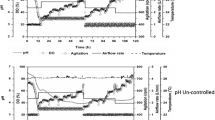Abstract
Improvement of microbial cell cultures oxygenation can be achieved by the increase of total air pressure, which increases oxygen solubility in the medium. In this work, a pressurized bioreactor was used for Yarrowia lipolytica batch cultivation under increased air pressure from 1 to 6 bar. Cell growth was strongly enhanced by the pressure rise. Fivefold and 3.4-fold increases in the biomass production and in specific growth rate, respectively, were observed under 6 bar. The increase of oxygen availability caused the induction of the antioxidant enzyme superoxide dismutase, which indicates that the defensive mechanisms of the cells against oxidative stress were effective and cells could cope with increased pressure. The pregrowth of Y. lipolytica under increased pressure conditions did not affect the lipase production ability of the cells. Moreover, the extracellular lipase activity increased 96% using a 5-bar air pressure instead of air at 1-bar pressure during the enzyme production phase. Thus, air pressure increase in bioreactors is an effective mean of cell mass and enzyme productivity enhancement in bioprocess based in Y. lipolytica cultures.




Similar content being viewed by others
References
Barth, G., & Gaillardin, C. (1996). In K. Wolf (Ed.), Nonconventional yeasts in biotechnology (pp. 313–388). Berlin, Germany: Springer-Verlag.
Zvyagilskaya, R., Andreishcheva, E., Soares, M. I. M., Khozin, I., Behre, A., & Persson, B. L. (2001). Journal of Basic Microbiology, 41, 289–303.
Aguedo, M., Gomes, N., Garcia, E. E., Waché, Y., Mota, M., Teixeira, J. A., et al. (2005). Biotechnology Letters, 27, 1617–1621.
Knoll, A., Bartsch, S., Husemann, B., Engel, P., Schroer, K., Ribeiro, B., et al. (2007). Journal of Biotechnology, 132(2), 167–179.
Charoenrat, T., Ketudat-Cairns, M., Jahic, M., Veide, A., & Enfors, S.-O. (2006). Biochemical Engineering Journal, 30, 205–211.
Knoll, A., Maier, B., Tscherrig, H., & Buchs, J. (2005). Advances in Biochemical Engineering Biotechnology, 92, 77–99.
Onken, U., & Liefke, E. (1989). Advances in Biochemical Engineering Biotechnology, 40, 137–169.
Izawa, S., Inoue, Y., & Kimura, A. (1995). FEBS Letters, 368, 73–76.
Moradas-Ferreira, P., Costa, V., Piper, P., & Mager, W. (1996). Molecular Microbiology, 19, 651–658.
Belo, I., Pinheiro, R., & Mota, M. (2003). Biotechnology Progress, 19, 665–671.
Pinheiro, R., Belo, I., & Mota, M. (2000). Enzyme and Microbial Technology, 26, 756–762.
Beers, R. F., & Sizer, I. W. (1952). Journal of Biological Chemistry, 195, 276–287.
Marklund, S., & Marklund, G. (1974). European Journal of Biochemistry, 47(3), 469–474.
Lopes, M., Gomes, N., Gonçalves, C., Coelho, M. A. Z., Mota, M., & Belo, I. (2008). Letters in Applied Microbiology, 46, 255–260.
Pinheiro, R., Belo, I., & Mota, M. (1997). Biotechnology Letters, 19(7), 703–708.
L’italien, Y., Thibault, J., & LeDuy, A. (1989). Biotechnology Letters, 15, 189–194.
Matsui, T., Shinzato, N., Yokota, H., Takahashi, J., & Sato, S. (2006). Process Biochemistry, 41(4), 920–924.
Han, J., & Zhong, J.-J. (2003). Enzyme and Microbial Technology, 32(3–4), 498–503.
Amaral, P. F. F., de Almeida, A. P., Peixoto, T., Rocha-Leão, M. H. M., Coutinho, J. A. P., & Coelho, M. A. Z. (2007). World Journal of Microbiology & Biotechnology, 23, 339–344.
Kawasse, F. M., Amaral, P. F., Rocha-Leão, M. H. M., Amaral, A. L., Ferreira, E. C., & Coelho, M. A. Z. (2003). Bioprocess and Biosystems Engineering, 25, 371–375.
Biryukova, E. N., Medentsev, A. G., Arinbasarova, A. Y., & Akimenko, V. K. (2006). Microbiology, 75(3), 243–247.
Puthli, M. S., Rathod, V. K., & Pandit, A. B. (2006). Biochemical Engineering Journal, 27, 287–294.
Destain, J., Fickers, P., Weekers, F., Moreau, B., & Thonart, P. (2005). Applied Biochemistry and Biotechnology, 121(1–3), 269–277.
Author information
Authors and Affiliations
Corresponding author
Rights and permissions
About this article
Cite this article
Lopes, M., Gomes, N., Mota, M. et al. Yarrowia lipolytica Growth Under Increased Air Pressure: Influence on Enzyme Production. Appl Biochem Biotechnol 159, 46–53 (2009). https://doi.org/10.1007/s12010-008-8359-0
Received:
Accepted:
Published:
Issue Date:
DOI: https://doi.org/10.1007/s12010-008-8359-0



